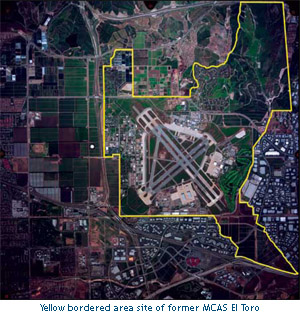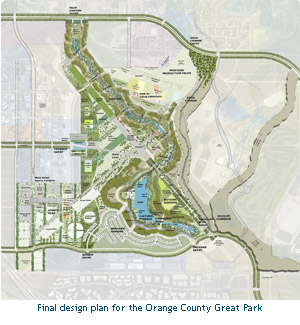BACKGROUND
 The Orange County Great Park, located in Irvine, CA occupies part of the former Marine Corps Air Station El Toro. The military facility was established in 1943 as a wartime air station. Throughout its history it has served as a training facility during peacetime, and as a staging area for military operations during times of conflict. The base formally closed in 1999. Immediately afterwards the County of Orange designated a Local Redevelopment Authority to develop a community reuse plan for the base. After a series of back and forth voter approved measures, Measure W was approved - the Orange County Central Park and Nature Preserve Initiative. Soon there after the military announced that they would sell the base via public auction. The city of Irvine responded immediately to this plan by developing the Great Park Plan.
The Orange County Great Park, located in Irvine, CA occupies part of the former Marine Corps Air Station El Toro. The military facility was established in 1943 as a wartime air station. Throughout its history it has served as a training facility during peacetime, and as a staging area for military operations during times of conflict. The base formally closed in 1999. Immediately afterwards the County of Orange designated a Local Redevelopment Authority to develop a community reuse plan for the base. After a series of back and forth voter approved measures, Measure W was approved - the Orange County Central Park and Nature Preserve Initiative. Soon there after the military announced that they would sell the base via public auction. The city of Irvine responded immediately to this plan by developing the Great Park Plan.
On February 16th, 2005 Lennar Corporation purchased four parcels of land totaling 4,369 acres representing the entire area encompassed by the former MCAS El Toro. This purchase marked the beginning of a unique partnership between the City of Irvine, the federal government, and a private landowner (Lennar Corp.) A development agreement was established between the City of Irvine and Lennar which stipulated that Lennar would be granted limited development rights (Great Park Communities) in return for the land and capital that will allow for the construction of the Orange County Great Park. The 1,347 acres that make up Orange County Great Park are under public ownership and Lennar Corp. must contribute $200 million dollars towards the development of the park. An additional $200 million dollars from taxes and fees will also be used to fund the creation of the park. At 1,347 acres the Orange County Great Park surpasses even that of Central Park which encompasses 843 acres of land. Some of the unique features within the park are: a Great Park Canyon, Great Lawn, Veterans Memorial, Sports Park, and Wildlife Corridor. Other public areas within the former base land include: a 1000 Life-Long Learning District, a cemetery, and 900 acres of open space. Since the park is under public ownership a non-profit organization was set up with the responsibility of designing, building, and maintaining the Great Park. The Orange County Great Park Corporation (OCGPC) is governed by a nine member Board of Directors.
RELEVANCE
 The Orange County Great Park represents an example of a city, in this case the city of Irvine, working with a developer from the beginning of a project, in order to ensure that its needs and wishes are met. The city was extremely proactive in developing a Great Park Plan immediately after the military announced the land was for sale. This plan was instrumental in helping the city clearly communicate its wishes to the developer (Lennar Corp.) To its credit Lennar Corp. was extremely receptive to the city's wishes. Additionally the final design for the Orange County Great Park was subject to a public participation campaign during which residents of the county were allowed to make their comments known about the final design. If some development should occur in the Woodland Lake Park Tract this case study demonstrates that the town of Pinetop-Lakeside needs to be proactive in voicing its desires and concerns and work in coercion with any future developer.
The Orange County Great Park represents an example of a city, in this case the city of Irvine, working with a developer from the beginning of a project, in order to ensure that its needs and wishes are met. The city was extremely proactive in developing a Great Park Plan immediately after the military announced the land was for sale. This plan was instrumental in helping the city clearly communicate its wishes to the developer (Lennar Corp.) To its credit Lennar Corp. was extremely receptive to the city's wishes. Additionally the final design for the Orange County Great Park was subject to a public participation campaign during which residents of the county were allowed to make their comments known about the final design. If some development should occur in the Woodland Lake Park Tract this case study demonstrates that the town of Pinetop-Lakeside needs to be proactive in voicing its desires and concerns and work in coercion with any future developer.
DESIGN IMPLICATIONS
- the town needs to be proactive and establish a development plan for the Woodland Lake Park Tract. While it is not 100% certain that development will occur within the tract area having a development strategy and plan established will inevitably prove beneficial to the town.
- the town can work alongside and in harmony with the right developer to ensure that its needs and desires are met.
- smart developers recognize the inherent value in preserving precious natural resources. Again the town needs to have those areas it deems of highest value identified and indicated in a development plan.
webdesign by chris rose
